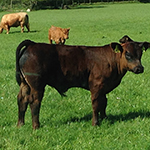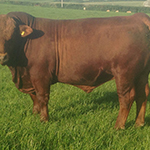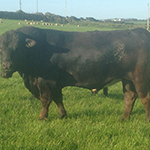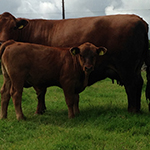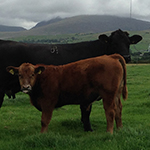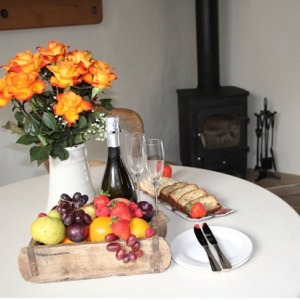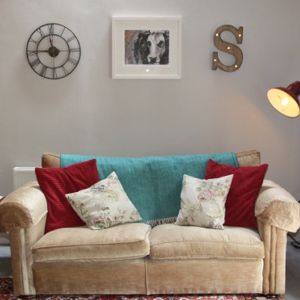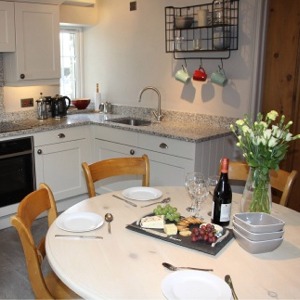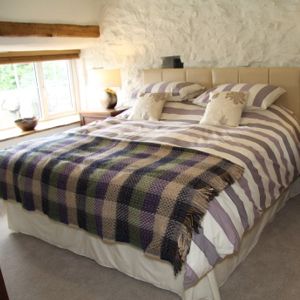
W
e manage a 700 acre farming business comprising of 3 separate units. The main farm, is 190 acres of owned ground at Crugeran which is adjoined by Bodnithoedd, a 200 acre tenanted farm that has been farmed by our family since 1949. A further 345 acres of upland ground owned land is based at Maesog, near Caernarfon. We also employ two general farm workers.
We have 210 Stabiliser cows with 120 calving on the mid March for 9 weeks and 90 calving mid June for 6 weeks. We run a 550 January lambing flock of New Zealand Suffolk x Lleyn ewes producing 40kg lambs off grass in 12 to 14 weeks, which we breed from our 300 February lambing Lleyn flock. We also grow 125acres arable consisting of 60ac barley, 15ac oats, 25ac red clover and 25ac swedes. This is consumed by our stock, barley, oats for the cattle and oats and swedes for the sheep. Having a closed herd and flock is very important for our business plan through low replacement cost and optimising production with high health status.
Our aim for the future is to keep producing good quality stock at low input costs by developing high genetic value animals that continue to push the boundaries of production without affecting the environment and also reducing carbon footprint. There’s more room for improvement in the suckler herd where there’s huge strides to be made, and in conjunction with the Stabiliser Cattle Company we will go forward in achieving this (e.g Net Feed Efficiency Centre, Givendale, York).
Technical
Around 2000 – 2001 Richard my husband decided to move the beef herd away from a traditional Freisian Limousin cross suckler cow to the Stabiliser breed. This was partly due to declining quality of the dairy Limousin cross cow with the increased influence of the Holstein breed on the national dairy herd and the lack of maternal traits in the breed. Richard was also looking for a cow that was easy to manage in a large herd situation with good fertility to maintain a tight calving pattern and easy of calving.
The Stabiliser breed was chosen. This is a composite breed made up of half native British beef breeds and half maternal Continental breeds. The breed offers a more sustainable herd replacement policy because of the ability to retain our own heifers. The breed also offers efficient maternal characteristics suiting a low input system while maintaining high levels of hybrid vigour and high output.
The farm became part of the “Cynhyrchwyr Biff Llyn” group that set up a stabiliser nucleus herd with technical help from Hybu Cig Cymru. Embryo transfer and Artificial insemination have been used on the herd to allow genetic progress.
Our son Harri is aiming to produce medium framed fleshy 600kg cows, with high genetic value. We push our cows hard on our upland farm and without creep feeding the calves we wean at 6 months old with the male calves weighing 250kg and female 230kg. With the average weight of a weaned calf being 240kg, this equates to 37% of the cows weight weaned. This is not high enough, our aim is 45% and with the strides we are making, reaching this within the system we run is achievable. We appreciate that this figure could go above 50% with the aid of creep feeding and/or using a terminal line bull such as Charolais. But applying these two things would increase the cost of production, which we don’t want to do. Our main aim of course is to produce efficient low input suckler cow replacements, and so the weaning weight of the calves is never going to be as high as when using terminal bulls for beef production.
Harri is more worried about the weight of the cow than the weight of the calf at weaning, because he knows with the genetic value of those calves and a little bit of compensatory growth the calves will reach their target weights of 610kg at 12 – 14 month for the male calves and between 380 – 400kg at bulling for the female calves. The male calves are left entire to produce breeding bulls and 12 to 14 month bull beef. At weaning they are put on to silage and gradually introducing concentrate in to the diet over a period of 4 weeks and by this time they should be eating 2.5% of their body weight of fresh matter in concentrate and 1% of their body weight of fresh matter in silage. At this time they also get access to ad-lib straw. The concentrate consists of Barley, Oats, Protein supplement, Minerals and Bi-carbonate. Because we grow our own feed and only buy in the protein supplement, we aim for the nutritional value of the diet to be ME-12, P-14 and Starch-30 without the cost running too high. The bull calves will be on this diet until they are 11 months old where we stop feeding the silage and lift the concentrate level to 3% of their body weight so that mainly the protein drops and allows the bulls to put that extra bit of flesh on before going off to slaughter. We aim for a 340kg R4L/-U4L carcass which is an average growth rate of 1.8kg/d from weaning to slaughter. All young cattle on feed are weighed monthly with feed adjusted accordingly. Our breeding bulls are left on the original diet with the possibility of turning them out to grass if sold and if the buyer wants to.
Ideally the female calves would be grazed on our lowland farm for 4 to 6 weeks after weaning and before housing but because of the priority of the bulling of our late summer calving cows on the same land, we have to house them. They will be put on to silage ad-lib and 1.5% bodyweight of the same concentrate as the bulls. The ME and Starch level of this is too high for them but due to ease of management that is what they get. Compared to the bulls which are pushed the heifers are stored over the winter where we hold them back to just 0.6kg/day. This and the growth they put on when turned out to grass enables us to hit the target of 380 to 400kg bulling weight at 14 months old.
We sell all of our cull cattle to slaughter mainly off grass but when not possible the cows go on ad-lib maize and heifers on 2% body weight concentrate and ad-lib maize.
As a multiplier farm within Beef Improvement Grouping Ltd, we sell breeding bulls and breeding heifers with high genetic value, bred commercially. Running the herd commercially is vital for producing an end product of efficient cows so we have to keep to tight rules. Because the herd has been in transition to a full pedigree Stabiliser herd over the last 13 years, high heifer replacement rates have been obtained. But now we have reached a stage where we have larger numbers of high genetic value breeding stock available. This now will enable Harri to speed up the breeding, focusing on fertility of the herd through choosing only the heifer calves born in the first 3 weeks of calving as replacements. Obviously breeding cattle from good EBVs is essential for progress but you need to look at the cattle as well. If they are not structurally up to the task e.g feet, legs, then there is no point. Structurally sound and good EBVs go hand in hand. By using embryo transfer from high genetic value cattle from America we are at the fore front of the Stabiliser genetic pool, enabling us to improve our herd and produce quality breeding heifers and bulls to sell.
A big part of reaching these goals is the health of the herd. We are part of the SAC Premium Cattle Health Scheme. The herd is BVD and Johnes Disease accredited and we also vaccinate for Lepto, IBR and a 10 in 1 clostridia vaccine.
In conjunction with genetics and health, soil and grassland management is vital for increasing production. Even though we put big emphasis on soil and run a very good grazing system with no grass gone to waste, we are always looking for ways to increase grass growth. The re-seeding we put in is high sugar varieties and we have started to use electrical fencing so that we can regulate grazing more vigorously with the option of implementing rotational grazing. To apply this when you have 3 or 4 different groups of cows running with a bull is hard. Maybe we could look at using more AI in the future so that the herd can run together over the bulling period.
If you have managed to read all of that and are still interested - please ask for a farm tour when you come to stay.

